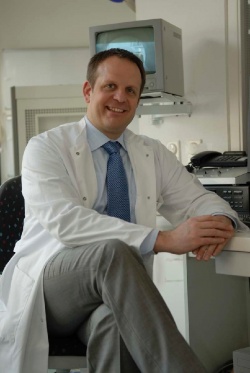The latest MRgFUS generation
As one of the first in Europe, the FUS Centre at the Klinikum Dachau in Germany introduced MRgFUS in 2008 as a gentle alternative for the treatment of fibroids. The success that has since been achieved in this encouraged Dr Matthias Matzko, head of radiology and of the FUS Centre, to take on a leading role with the introduction to the market of the second product generation, the ExAblate One. Since November 2010 Dr Matzko and his team have been working with the latest MRgFUS technology supplied by GE Healthcare and InSightec. Speaking with Meike Lerner of European Hospital the radiologist outlined their work with the new equipment, which he refers to as a ‘quantum leap’ for patients as much as the users

‘The entire design interface was revised for the ExAblate One, which facilitates volumetric planning of the ablation area with different spot sizes, taking into account the size of the fibroid and the necessary tilting of the ultrasound fixture. So far, this had been the responsibility of the doctor and required extensive experience to achieve the best possible results. However, the main attraction of the system is actually the improved energy efficiency -- it’s using up to 60% more energy whilst maintaining a lower energy dose on the skin surface’, Dr Matzko explained.
This is possible through the ‘5th degree of freedom’ of the ultrasound mirror, which not only - as before – can be moved in all four directions, but additionally towards the patient and therefore the target region. Dr Matzko: ‘This allows us to keep the energy level on the skin low and to direct the excess energy down into the tissue. In this way, the significant advantage we achieve is that we can sound through scar tissue. Thanks to the new technology it’s also possible to treat the large number of women who previously could not be treated, because of C-section scars for instance.’
The same applies to women suffering from fibroids that are strongly perfused. This used to be an exclusion criterion for the treatment because stronger perfusion led to discharging of the energy. ‘We differentiate between three groups of fibroids: those with weak perfusion, medium perfusion and strong perfusion. Due to the higher energy level we can now also successfully treat women in the second group. However, very strongly perfused fibroids are, at least for us, still not suitable for this treatment.’
This new range of treatment indications ensured that the uptake quota since the ExAblate One was brought into service in mid November 2010 rose from 30% to 50%, i.e. to around 25 patients a month. ‘Due to the reduced energy density the cooling down periods between individual treatments with the new system are shorter, which reduces the length of treatment as such,’ he explained.
The fact that the Dachau Centre has made a name for itself in fibroid treatment is not only due to technology and the doctors’ expertise. As one of the few centres of its kind in Germany, the Bavarians have succeeded in cooperating with the two largest medical insurers in the country, which have been covering MRgFUS treatment since the beginning of 2010. Due to this support, the quality and success requirements are comparatively high – a further reason to equip the centre with state-of-the-art technology.
Dr Matzko also sees considerable development potential for high focus ultrasound (FUS) in other areas: ‘Its application is particularly promising in the case of treatment for peripheral zone prostate cancer, which is currently being carried out both in St Petersburg and London. The tumour is destroyed with a special probe, which is inserted via the rectum, and the organ is preserved. In addition, Japanese studies confirm the benefit of the procedure for the treatment of breast cancer. A first phase with FUS ablation followed by surgical excision of the tumour has already shown that around 96% of the malignant tissue can be removed through the ablation.
‘In a second phase, there are currently attempts to find out how safe MRgFUS followed by combined chemotherapy and radiotherapy is – without surgical excision of the tumour initially ablated with FUS.
‘A third potential area is the application of this type of ultrasound for bone metastases, which can lead not only to a signification reduction in pain but, based on the latest findings, also can keep inoperable metastases in check over long periods of time.’
Until all these types of treatment become standard practice, the Dachau Centre will continue to concentrate on using the technology for gynaecological applications and on further expanding the excellence of the centre.
10.03.2011











